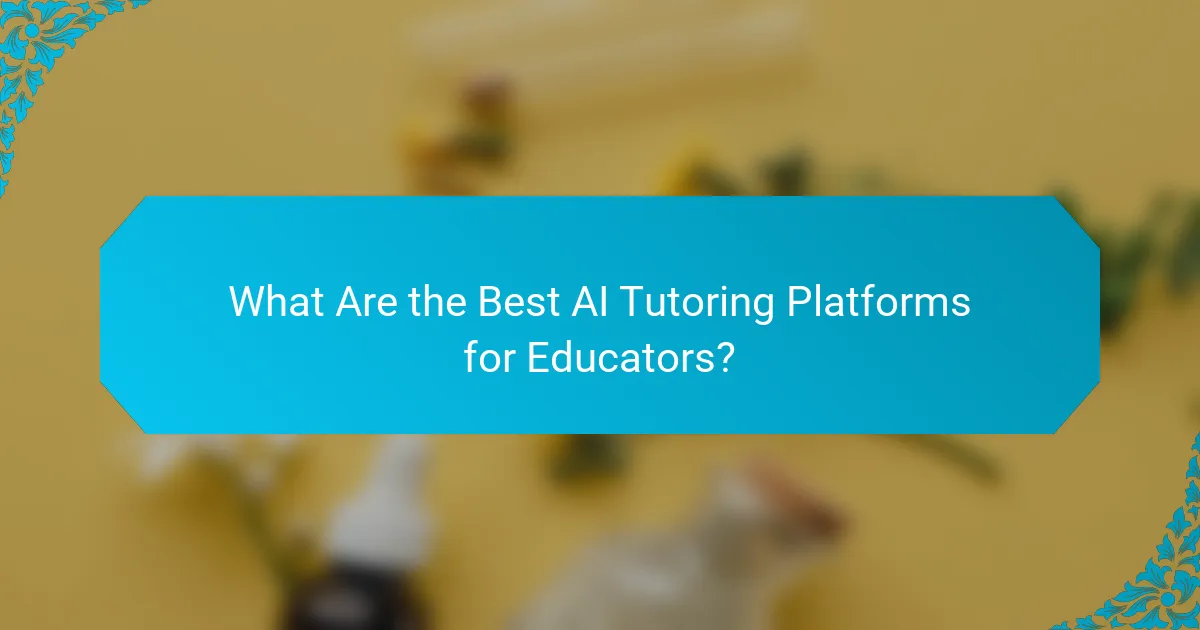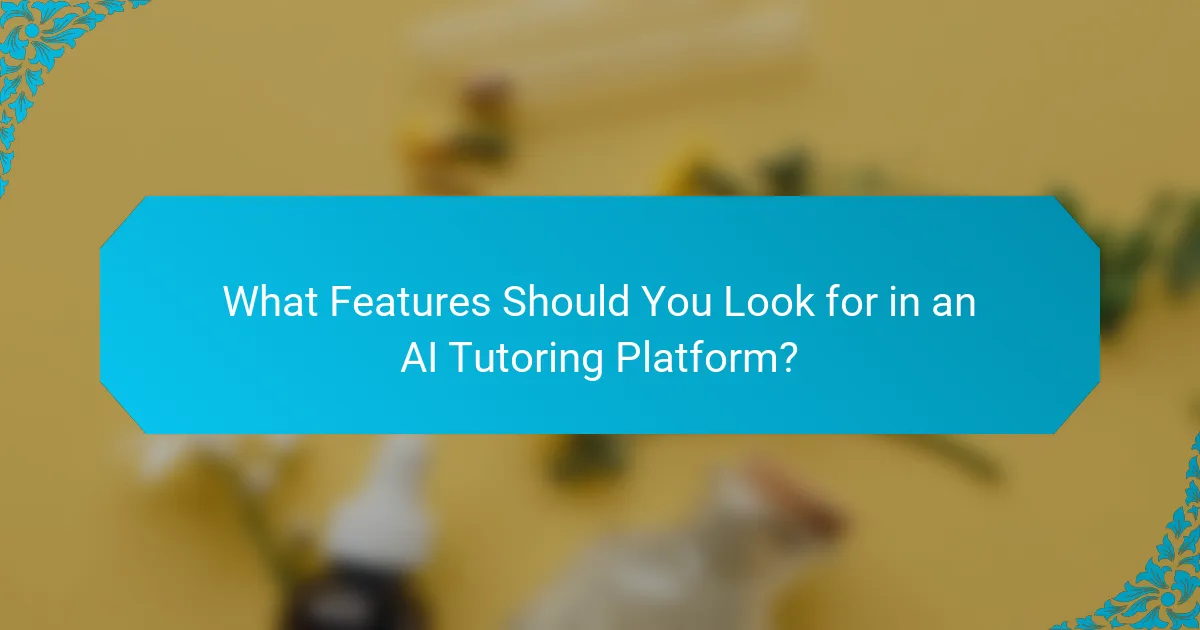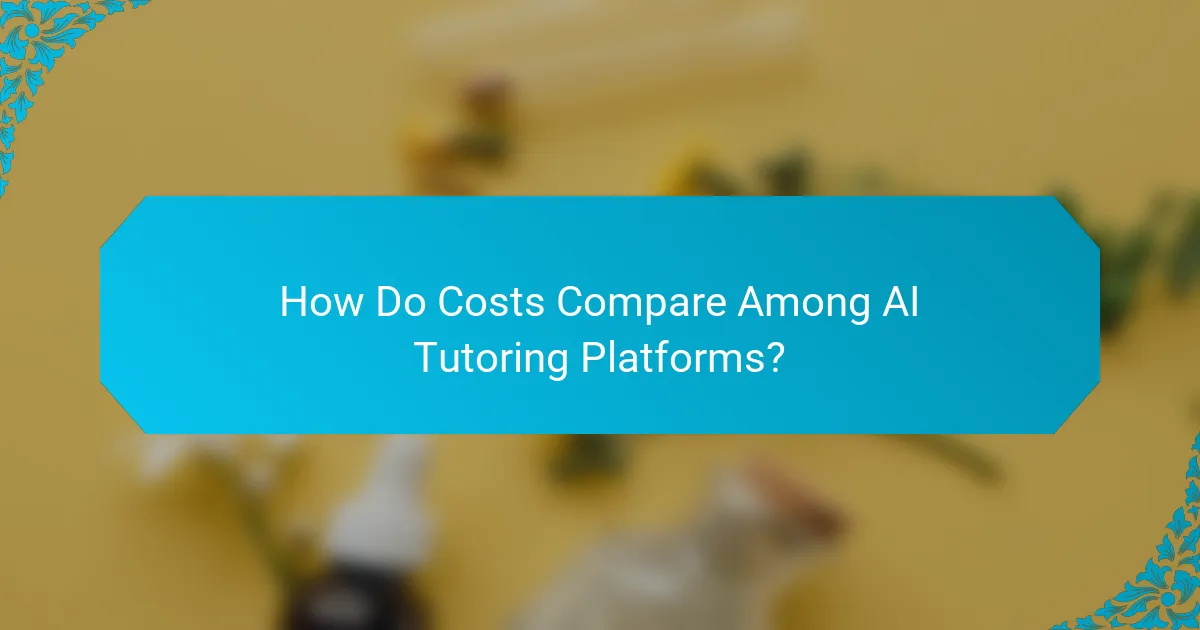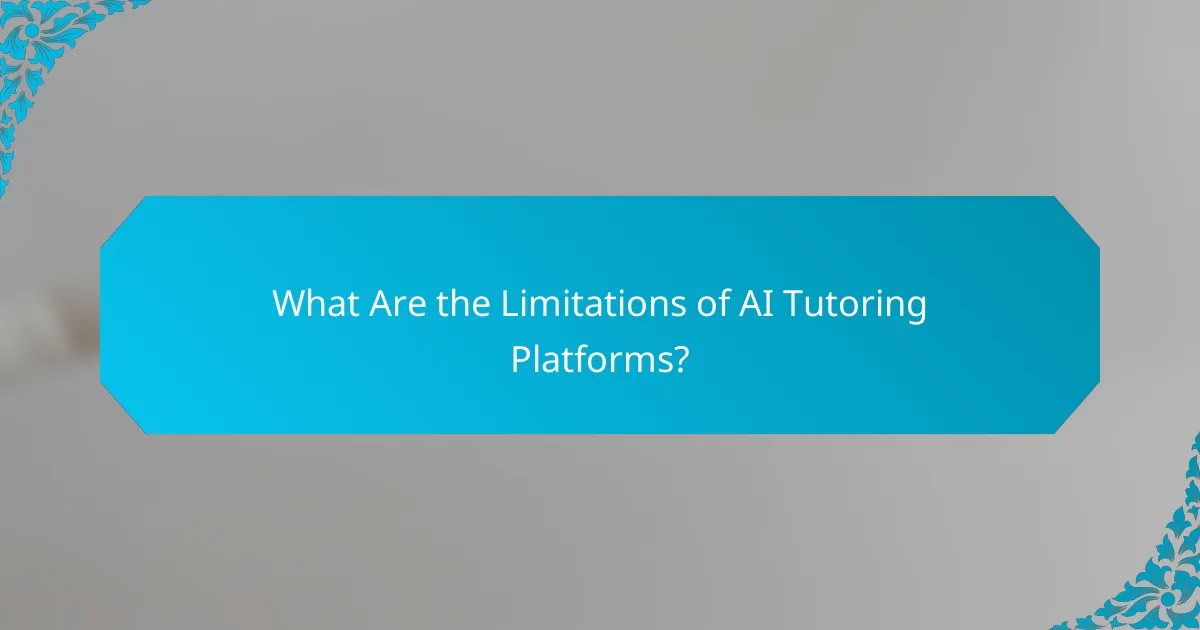AI tutoring platforms are revolutionizing education by offering personalized learning experiences that cater to individual student needs. By integrating with tools like Google Classroom and various Learning Management Systems, these platforms enhance teaching efficiency and foster better communication between educators and students. With advanced algorithms, they provide tailored content and immediate feedback, making learning more engaging and effective.

What Are the Best AI Tutoring Platforms for Educators?
The best AI tutoring platforms for educators include tools that enhance teaching efficiency and student engagement. These platforms leverage artificial intelligence to provide personalized learning experiences, streamline administrative tasks, and facilitate communication between teachers and students.
Google Classroom
Google Classroom is a widely used platform that integrates seamlessly with other Google services. It allows educators to create classes, distribute assignments, and provide feedback in real-time. The AI features help in organizing coursework and tracking student progress effectively.
Educators can utilize Google Classroom to set up quizzes and assignments that adapt to student performance, making it easier to identify areas where students may need additional support. The platform is free for educational institutions, making it accessible for schools of all sizes.
Edmodo
Edmodo is a social learning platform that connects educators, students, and parents. It offers tools for assignment management, grading, and communication, all enhanced by AI capabilities that personalize learning experiences. Edmodo’s interface is user-friendly, making it easy for teachers to engage with their students.
One of the key features of Edmodo is its ability to create groups for collaborative projects, allowing students to learn from each other. The platform also provides analytics to help teachers monitor student engagement and performance, which can inform instructional strategies.
Khan Academy
Khan Academy offers a wealth of resources for educators and students, focusing on personalized learning through its AI-driven platform. The system adapts to individual student needs, providing tailored exercises and instructional videos based on their progress.
Teachers can assign specific content to students and track their mastery of subjects in real-time. This platform is particularly useful for supplemental learning, as it covers a wide range of subjects and is free to use, making it accessible for all learners.
Coursera
Coursera partners with universities and organizations to provide high-quality courses that can be integrated into educational curricula. Its AI features help recommend courses and learning paths based on student interests and performance, enhancing the learning experience.
Educators can leverage Coursera to offer students access to a diverse array of subjects, from computer science to humanities. While some courses are free, others may require payment, so educators should consider budget constraints when integrating this platform into their teaching.
Duolingo
Duolingo is an innovative language-learning platform that uses AI to personalize lessons and track student progress. Its gamified approach makes learning engaging, encouraging students to practice regularly through interactive exercises.
Teachers can use Duolingo to supplement language instruction, assigning specific lessons and monitoring student performance. The app is free, with optional premium features, making it an affordable option for educators looking to enhance language acquisition in their classrooms.

How Do AI Tutoring Platforms Enhance Learning?
AI tutoring platforms enhance learning by providing tailored educational experiences that adapt to individual student needs. These systems leverage advanced algorithms to offer personalized content, immediate feedback, and valuable insights based on student performance.
Personalized Learning Experiences
Personalized learning experiences are a hallmark of AI tutoring platforms, allowing students to engage with material that matches their unique learning pace and style. For instance, platforms can adjust the difficulty of exercises based on a student’s previous answers, ensuring they remain challenged yet not overwhelmed.
Additionally, these systems can recommend resources such as videos, articles, or practice problems that align with a student’s interests and strengths. This targeted approach helps maintain motivation and fosters deeper understanding.
Real-Time Feedback
Real-time feedback is crucial in the learning process, and AI tutoring platforms excel in providing it instantly. As students work through problems, they receive immediate corrections and suggestions, which helps them grasp concepts more effectively.
This immediate response can significantly reduce the time spent on misunderstandings, allowing learners to adjust their strategies on the fly. For example, if a student struggles with a math problem, the platform might offer hints or alternative methods to solve it, enhancing comprehension.
Data-Driven Insights
Data-driven insights from AI tutoring platforms provide educators and students with a clearer picture of learning progress and areas needing improvement. By analyzing patterns in student performance, these systems can identify strengths and weaknesses, guiding future learning paths.
Teachers can utilize these insights to tailor their instruction, focusing on group trends or individual challenges. For instance, if a class consistently struggles with a specific topic, educators can adjust their teaching strategies or provide additional resources to address these gaps effectively.

What Features Should You Look for in an AI Tutoring Platform?
When choosing an AI tutoring platform, prioritize features that enhance personalized learning experiences, ease of use, and compatibility with your existing educational tools. Key elements include adaptive learning algorithms, a user-friendly interface, and seamless integration with systems like Google Classroom or other Learning Management Systems.
Adaptive Learning Algorithms
Adaptive learning algorithms customize educational content based on individual student performance and learning pace. These algorithms analyze data to identify strengths and weaknesses, allowing the platform to adjust the difficulty and type of material presented.
Look for platforms that offer real-time feedback and personalized learning paths. For example, an effective AI tutoring system might provide additional practice problems in areas where a student struggles, ensuring targeted support.
User-Friendly Interface
A user-friendly interface is crucial for both students and educators to navigate the platform efficiently. An intuitive design minimizes the learning curve and encourages engagement, making it easier for users to access resources and track progress.
Consider platforms that feature clear navigation, visually appealing layouts, and mobile compatibility. A straightforward dashboard that displays assignments, grades, and learning objectives can significantly enhance the user experience.
Integration with Existing Systems
Integration with existing educational systems, such as Google Classroom or other Learning Management Systems, is essential for a seamless experience. This feature allows for easy data transfer, reducing administrative burdens and ensuring that all learning materials are accessible in one place.
Check if the platform supports Single Sign-On (SSO) and can sync with grade books or attendance systems. This compatibility not only saves time but also helps maintain accurate records across different platforms.

How Do Costs Compare Among AI Tutoring Platforms?
The costs of AI tutoring platforms vary significantly based on features, accessibility, and user needs. Understanding the pricing structures of platforms like Google Classroom, Edmodo, and Khan Academy can help educators and students make informed decisions.
Google Classroom Pricing
Google Classroom is free for educational institutions using Google Workspace for Education. This makes it an attractive option for schools looking to integrate AI tutoring without incurring additional costs.
While the platform itself is free, schools may need to consider costs associated with Google Workspace subscriptions for advanced features, which can range from $3 to $25 per user per month, depending on the plan selected.
Edmodo Pricing
Edmodo offers a free basic version, which includes essential features for classroom management and communication. However, for enhanced functionalities, such as advanced analytics and integrations, schools can opt for Edmodo’s premium plans, which typically range from $10 to $50 per month per teacher.
It’s important to evaluate the specific needs of your institution to determine if the premium features justify the additional expense.
Khan Academy Free Access
Khan Academy is entirely free for users, providing a wealth of resources and AI-driven tutoring tools without any cost. This makes it a valuable resource for students and educators seeking supplemental learning materials.
Since Khan Academy operates on a donation-based model, users are encouraged to support the platform if they find it beneficial, but there are no mandatory fees involved.

What Are the Limitations of AI Tutoring Platforms?
AI tutoring platforms have several limitations that can impact their effectiveness in educational settings. These include a lack of personalized interaction, potential biases in algorithms, and challenges in addressing diverse learning styles.
Limited Personalization
While AI tutoring platforms can adapt to some degree, they often struggle to provide the level of personalization that a human tutor can offer. For instance, they may not fully understand a student’s unique emotional or motivational needs, which can hinder engagement and learning outcomes.
Students may find that AI systems provide generic feedback rather than tailored advice. This can lead to frustration, especially for those who require more nuanced support to grasp complex concepts.
Algorithmic Bias
AI tutoring platforms can inadvertently perpetuate biases present in their training data. This may result in unequal learning opportunities for students from diverse backgrounds. For example, if an AI system is primarily trained on data from a specific demographic, it may not effectively serve students outside that group.
Educators should be aware of these biases and consider supplementing AI tools with human oversight to ensure equitable learning experiences. Regular audits of AI systems can help identify and mitigate these issues.
Inflexibility with Learning Styles
AI tutoring platforms often employ standardized approaches that may not cater to all learning styles. For example, visual learners may benefit from interactive graphics, while auditory learners might prefer spoken explanations. If an AI system does not accommodate these preferences, students may struggle to engage with the material.
To enhance effectiveness, educators should combine AI tools with varied teaching methods. This hybrid approach can help address the diverse needs of students and improve overall learning outcomes.
